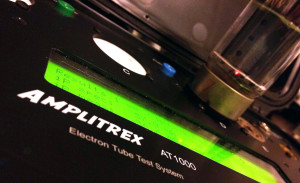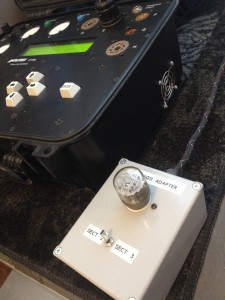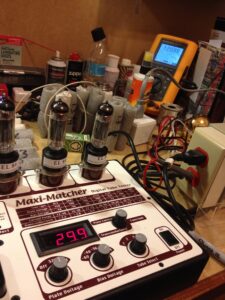TUBE TESTING
Vacuum Tubes are the heart of any good tube amplifier
 This is why Desert Amplifier Repair uses the Amplitrex AT1000 Tube Analyzer to test every tube that comes in. This testing service is always included in the basic estimate. The Amplitrex accurately tests hundred of popular tubes, as well as allows us to create our own custom tube tests with regulated power supplies producing actual operating voltages up to 500 volts. The test parameters include: emission, transconductance (GM), gas, and heater to cathode leakage.
This is why Desert Amplifier Repair uses the Amplitrex AT1000 Tube Analyzer to test every tube that comes in. This testing service is always included in the basic estimate. The Amplitrex accurately tests hundred of popular tubes, as well as allows us to create our own custom tube tests with regulated power supplies producing actual operating voltages up to 500 volts. The test parameters include: emission, transconductance (GM), gas, and heater to cathode leakage.
The Amplitrex AT1000 allows us to weed through tubes and pick out the good from the bad, as well as select matched and balanced tubes for phase inverters. Because of the ability to test at actual operating voltages, we’re also able to match power tubes with incredible accuracy and reliability.
 To cover all the Ampeg V4 series amplifiers, we had a custom test jig and preset made for the 6K11 tube, allowing us to test all 3 sides. Why this matters: most tube testers outside of a laboratory test at a limited or starved voltage, so the tube that tests good at “X” voltage (for example, 100 volts) might perform completely different at 500 volts. To make it simpler, think back to PE class when you had to run the mile. It was a lot easier to walk (100 volts) than to run (500 volts). Remember how many of your classmates ended up walking? Most tube testers also use an unregulated power supplies to test the tubes. This means that as the testing location’s main power fluctuates, so does the test voltage and ultimately the test results. When it comes to calibration, the test itself is only as good as the calibration. Most old tube testers use an analog dial, and while a good number of the dials are of quality, it’s ultimately left up to a person to interpret the test results, so the test is only as truthful as the person reading the dial. The Amplitrex displays the test results on an all digital display, or on the computer on a test result sheet. These are some of the reasons we picked the Amplitrex AT1000. We take pride in our work and having the proper tool for the job goes a long way to getting the results we strive for. We don’t want your amplifier to just work, we want your amplifier to sound it’s best, for as long as possible.
To cover all the Ampeg V4 series amplifiers, we had a custom test jig and preset made for the 6K11 tube, allowing us to test all 3 sides. Why this matters: most tube testers outside of a laboratory test at a limited or starved voltage, so the tube that tests good at “X” voltage (for example, 100 volts) might perform completely different at 500 volts. To make it simpler, think back to PE class when you had to run the mile. It was a lot easier to walk (100 volts) than to run (500 volts). Remember how many of your classmates ended up walking? Most tube testers also use an unregulated power supplies to test the tubes. This means that as the testing location’s main power fluctuates, so does the test voltage and ultimately the test results. When it comes to calibration, the test itself is only as good as the calibration. Most old tube testers use an analog dial, and while a good number of the dials are of quality, it’s ultimately left up to a person to interpret the test results, so the test is only as truthful as the person reading the dial. The Amplitrex displays the test results on an all digital display, or on the computer on a test result sheet. These are some of the reasons we picked the Amplitrex AT1000. We take pride in our work and having the proper tool for the job goes a long way to getting the results we strive for. We don’t want your amplifier to just work, we want your amplifier to sound it’s best, for as long as possible.
 In addition to the Amplitrex we also have a Maxi-Matcher in the shop. This piece of equipment is used to match up to 4 power tubes with pre-selected bias points and plate voltages selectable between 325V and 400V. Because of this voltage limitation, it’s use is limited mostly to 6V6, 6L6, and EL84 type tubes, though we do have the full assortment of test adapters for testing other tube types on the Maxi-Matcher. We purchased the Maxi-Matcher because it was the industry standard for tube supply houses for decades, and we would consistently receive tubes that were poorly matched and performed terribly in amplifiers under actual operating voltages, so owning this tester gave us a way of holding the suppliers accountable for poorly matched tubes. If the tube isn’t tested/matched at the voltages in which it operates, the test is meaningless.
In addition to the Amplitrex we also have a Maxi-Matcher in the shop. This piece of equipment is used to match up to 4 power tubes with pre-selected bias points and plate voltages selectable between 325V and 400V. Because of this voltage limitation, it’s use is limited mostly to 6V6, 6L6, and EL84 type tubes, though we do have the full assortment of test adapters for testing other tube types on the Maxi-Matcher. We purchased the Maxi-Matcher because it was the industry standard for tube supply houses for decades, and we would consistently receive tubes that were poorly matched and performed terribly in amplifiers under actual operating voltages, so owning this tester gave us a way of holding the suppliers accountable for poorly matched tubes. If the tube isn’t tested/matched at the voltages in which it operates, the test is meaningless.
While the Maxi-Matcher does have a digital read out, it’s power supply is not regulated which has led to a lot of the inaccurate test results mentioned above. To solve this problem we had a CVT (constant voltage transformer) modified to power the tester. The CVT makes sure that the tester maintains a secondary operating voltage within 0.025 volts at all times. Without the CVT, the voltage could fluctuate as much as 40 volts depending on what the main power’s fluctuation of the primary voltage would be. One thing that the Maxi-Matcher does do very well is isolate tubes that have voltage issues, shorts, and excessive current draw. It’s also great for matching tubes that have tested good on the Amplitrex AT1000, assuring they are free of gas, microphonics, and leakage.
